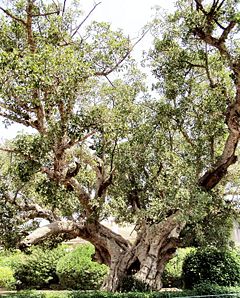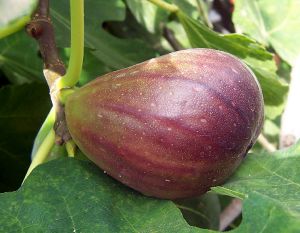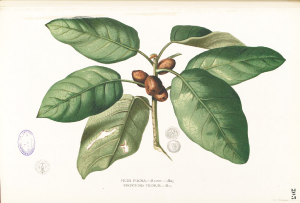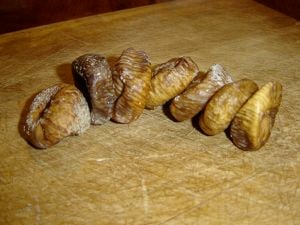Fig
| Ficus | ||||||||||||
|---|---|---|---|---|---|---|---|---|---|---|---|---|
 Ficus sycomorus
| ||||||||||||
| Scientific classification | ||||||||||||
| ||||||||||||
|
About 800, including: |
| Figs, fresh Nutritional value per 100 g | ||||||||
|---|---|---|---|---|---|---|---|---|
| Energy 70 kcal 310 kJ | ||||||||
| ||||||||
| Percentages are relative to US recommendations for adults. Source: USDA Nutrient database | ||||||||
| Figs, dried Nutritional value per 100 g | ||||||||
|---|---|---|---|---|---|---|---|---|
| Energy 250 kcal 1040 kJ | ||||||||
| ||||||||
| Percentages are relative to US recommendations for adults. Source: USDA Nutrient database | ||||||||
Ficus is a genus of about 800 species of woody trees, shrubs and vines in the family Moraceae, native throughout the tropics with a few species extending into the warm temperate zone. The most well known species in the genus is the Common Fig.
One species of this genus, the Common Fig (F. carica), produces a commercial fruit called a fig; the fruit of many other species are edible though not widely consumed. Other examples of figs include the banyans and the Sacred Fig (Peepul or Bo) tree. Most species are evergreen, while some from temperate areas, and areas with a long dry season, are deciduous.
Fruit and pollination
The fig is commonly thought of as fruit, but it is properly the flower of the fig tree. It is in fact a false fruit or multiple fruit, in which the flowers and seeds grow together to form a single mass.
The genus Dorstenia, also in the fig family (Moraceae), exhibits similar tiny flowers arranged on a receptacle but in this case the receptacle is a more or less flat, open surface.
A fig "fruit" is derived from a specially adapted type of inflorescence (structural arrangement of flowers). What is commonly called the "fruit" of a fig is actually a specialized structure- or accessory fruit- called a syconium: an involuted (nearly closed) receptacle with many small flowers arranged on the inner surface. Thus the actual flowers of the fig are unseen unless the fig is cut open. In Chinese the fig is called 'fruit without flower'. The syconium often has a bulbous shape with a small opening (the ostiole) at the distal end that allows access by pollinators. The flowers are pollinated by very small wasps that crawl through the opening in search of a suitable place to reproduce (lay eggs). Without this pollinator service fig trees cannot reproduce by seed. In turn, the flowers provide a safe haven and nourishment for the next generation of wasps. Technically, a fig fruit would be one of many mature, seed-bearing flowers found inside one fig.
Most figs come in two sexes: hermaphrodite (called caprifigs from goats - Caprinae subfamily; as in fit for eating by goats; sometimes called "inedible") and female (the male flower parts fail to develop; produces the "edible" fig). Fig wasps grow in caprifigs but not in the other because the female trees' female flower part is too long for the wasp to successfully lay her eggs in them. Nonetheless, the wasp pollinates the flower with pollen from the fig it grew up in, so figs with developed seeds also contain dead fig wasps almost too tiny to see.
When a caprifig ripens, another caprifig must be ready to be pollinated. Tropical figs bear continuously[citation needed], enabling fruit-eating animals to survive the time between mast years. In temperate climes, wasps hibernate in figs, and there are distinct crops. Caprifigs have three crops per year; edible figs have two. The first of the two is small and is called breba; the breba figs are olynths. Some selections of edible figs do not require pollination at all, and will produce a crop of figs (albeit without fertile seeds) in the absence of caprifigs or fig wasps.
There is typically only one species of wasp capable of fertilizing the flowers of each species of fig, and therefore plantings of fig species outside of their native range results in effectively sterile individuals. For example, in Hawaii, some 60 species of figs have been introduced, but only four of the wasps that fertilize them have been introduced, so only four species of figs produce viable seeds there.
Propagation
Figs are also easily propagated from cuttings. An extraordinarily large self-rooted Wild Willowleaf Fig in South Africa is protected by the Wonderboom Nature Reserve.
Historical significance
In June 2006, it was reported that figs dating back 11,400 years were discovered at Gilgal I, a village in the Lower Jordan Valley, just 8 miles north of ancient Jericho.[citation needed] There is evidence that figs were among the first cultivated crop, because they were of a mutation which could not reproduce normally. It is proposed that they may have been planted and cultivated intentionally, one thousand years before the next crops were domesticated (wheat and rye).
The phallic shape of the young fig is referred to in Song of Songs chapter 2 verse 13. The fig tree is sacred to Dionysus Sukites (Συκίτης).
Figs were also a common foodsource for the Romans. Cato the Elder, in his De Agri Cultura, lists several strains of figs grown at the time he wrote his handbook: the Mariscan, African, Herculanean, Saguntine, and the black Tellanian (De agri cultura, ch. 8).
Figs and health
Figs are good source of flavonoids and polyphenols[1]. Figs and other dried fruit were measured for their antioxidant content. A 40 gram portion of dried figs (two medium size figs) produced significant increase in plasma antioxidant capacity [2]. Figs also have higher quantities of fiber than any other dried or fresh fruit, and are very high in calcium.
See also
- List of fruits
- Moreton Bay Fig
- Fig Newton
- Miracles of Jesus – the Cursing of The Fig Tree
Credits
New World Encyclopedia writers and editors rewrote and completed the Wikipedia article in accordance with New World Encyclopedia standards. This article abides by terms of the Creative Commons CC-by-sa 3.0 License (CC-by-sa), which may be used and disseminated with proper attribution. Credit is due under the terms of this license that can reference both the New World Encyclopedia contributors and the selfless volunteer contributors of the Wikimedia Foundation. To cite this article click here for a list of acceptable citing formats.The history of earlier contributions by wikipedians is accessible to researchers here:
The history of this article since it was imported to New World Encyclopedia:
Note: Some restrictions may apply to use of individual images which are separately licensed.
External links
- Figweb Major reference site for the genus Ficus
- Video: Interaction of figs and fig wasps Multi-award-winning documentary
- Fruits of Warm Climates: Fig
- California Rare Fruit Growers: Fig Fruit Facts
- North American Fruit Explorers: Fig
- BBC: Fig fossil clue to early farming



